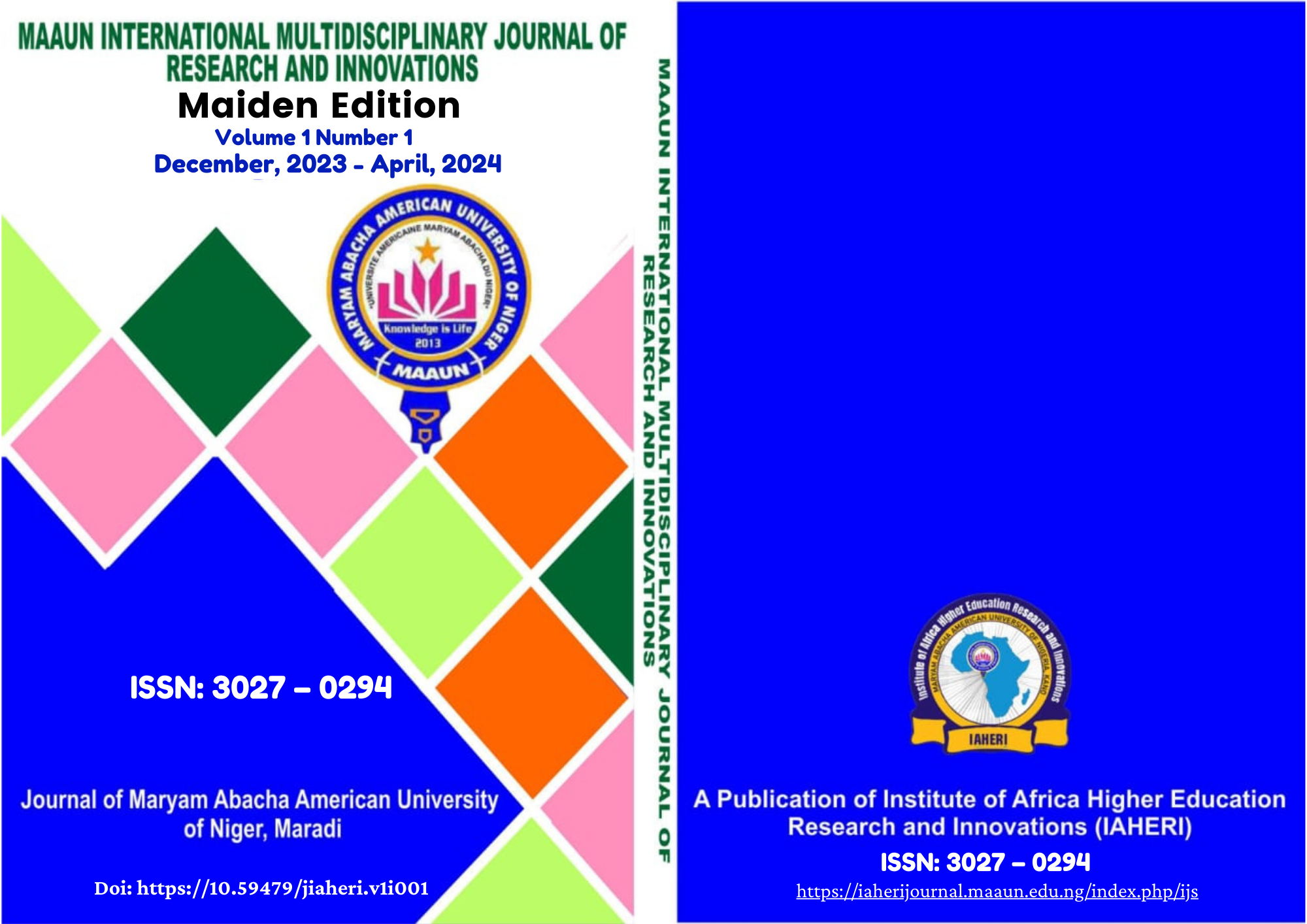Effectiveness of Jogging Programme on Cardio Respiratory Fitness of Almajirai in Gusau Metropolis, Nigeria: Health Implications
Published 10/14/2024
Keywords
- Jogging programme,
- cardio respiratory fitness,
- and almajirai
How to Cite
Abstract
This study examined the effectiveness of a jogging program on the cardiorespiratory fitness of almajirai (Islamic students) in Gusau Metropolis, Nigeria. Cardiorespiratory fitness is an important indicator of physical and overall health, as it reflects the body's ability to transport and utilize oxygen during sustained physical activity. A repeated measures research design was used, with 48 male almajirai randomly assigned to either an experimental group that participated in the jogging program or a control group that did not. The experimental group engaged in a structured jogging program 3 times per week for 8 weeks, with the intensity and duration gradually increasing over the course of the program. Cardiorespiratory fitness was assessed at baseline, after 4 weeks, and after 8 weeks using a 9-minute walk/run test, from which VO2max (maximal oxygen uptake) was estimated. Repeated measures ANOVA revealed a significant effect of the jogging program on cardiorespiratory fitness (F = 23.655, p < 0.05). Post-hoc analyses showed no significant difference in cardiorespiratory fitness between baseline and week 4, but significant improvements were observed between baseline and week 8, as well as between week 4 and week 8. This indicates that the jogging program had a positive and cumulative effect on the almajirai's cardiorespiratory fitness over the 8-week period. These findings recommended that structured aerobic exercise, such as a jogging program, can effectively improve the cardiorespiratory fitness of almajirai in Gusau Metropolis. Incorporating regular physical activity into the almajirai's routine may have important health benefits, including reduced risk of cardiovascular disease, improved lung and heart function, and enhanced overall physical fitness and well-being.
References
- Aaronson, P. I.; J. P. T. Ward, and M. J. Connolly. (2012). The Cardiovascular System at a Glance, Wiley, Hoboken, NJ, USA, 4th edition.
- Blake, H. (2011) Cardio-Respiratory Endurance Exercise. http://www.livestory.com/article /132351/cardiorespiratory endurance-exercise
- Boiarskaia, E.A., Boscolo, M., Zhu, W., & Mahar, M.T. (2011). Cross-validation of an equating method linking aerobic FITNESSGRAM® field tests. American journal of preventive medicine, 41 4 Suppl 2, 124-30.
- Carnethon MR, Gidding SS, Nehgme R, Sidney S, Jacobs DR Jr, Liu K. Cardiorespiratory fitness in young adulthood and the development of cardiovascular disease risk factors. JAMA. 2003 Dec 290 (23), 3092-100. doi:10.1001/jama.290.23.3092. PMID: 14679272.
- Chado, M. A. (1990). Health Maintenance through Active Life Stye”. (Unpublished paper), Presented to M.Sc. Class in Exercise Physiology, Department of Physical & Health Education, Ahmadu Bello University, Zaria, Nigeria.
- Dumitru, M. (2011). Physical Education and Teaching Methodology. Constanta: EX-Ponto Press.
- Gulati M, Black HR, Shaw LJ, Arnsdorf MF, Merz CN, Lauer MS, et al. (2005). The Prognostic Value of a Nomogram for Exercise Capacity in Women. North England Journal of Medical (353), 468–475.
- Howley, E. T., & Franks, B. D. (1992). Health fitness instructor's handbook. 2nd ed. Champaign, Ill., Human Kinetics Books.
- Huck, S.W., & Cormier, W.H. (1996). Reading statistics and research (2nd ed.). New York: Harper Collins
- Jackson AS, Sui X, Hebert JR, Church TS and Blair SN (2009). Role of Lifestyle and Aging on the Longitudinal Change in Cardiorespiratory Fitness. Archaeology International Journal (169), 1781–1787.
- Lewis, C. (1993). Analyzing means from repeated measures data. In G. Keren & C. Lewis (eds.), A Handbook for data analysis in the behavioral sciences, 73-94. Hillsdale, NJ: Erlbaum.
- Myers J, Prakash M, Froelicher V, Do D, Partington S and Atwood J.E (2002). Exercise Capacity and Mortality among Men referred for Exercise Testing. North England Journal Medical (346), 793–801.
- Ndagi, J. O. (1999). Essentials of Research Methodology for Educators. Ibadan: University Press Plc.
- Perry, (1998).Aging and Muscles functions.American Sports Medicine Science. 516-396.
- Pollock, M.L., Gaesser, G.A., Butcher, J.D., Després, J., Dishman, R.K., Franklin, B.A., & Garber, C.E. (1998). ACSM Position Stand: The Recommended Quantity and Quality of Exercise for Developing and Maintaining Cardiorespiratory and Muscular Fitness, and Flexibility in Healthy Adults. Medicine and Science in Sports and Exercise, (30), 975-991.
- Rebeka, C. (2019). A decade of research literature in sport coaching (2005–2015). International Journal of Sports Science & Coaching, 14(2), 205–215. https://doi.org/10.1177/1747954118825058
- Rowland, T.W. & Boyajian, A. (2015). Aerobic Response to Endurance Exercise Training in Children. Pediatrics, (96), 654-658.
- Seaton, D.C., Clayton, I., Leibee, H. & Messersmith, L. (2010): Physical Education Hand Book.
- Siddiqui NI, Nessa A, Hossain MA. (2010). www.ncbi.nim.nih.gov.dubmed: http://www.motleyhealth.com/fitness/health-benefits-of-jogging-andrunning#ixzz1SfqxbiSU.
- Suma H, Rajeshwari S and Nutan B. (2005). Anthropologist, 7, 185-187.
- Tipton C. H. and Schever J. K (1991). Exercise Training and Hypertension. Holloszy J. 0. (ed) Exercise and Sport Sciences Reviews 19, 447 —500.
- Tudor-Locke, C, Ainsworth, B. E, Popkin, B. M. (2001). Active Commuting to School: An Overlooked Source of Students’ Physical Activity? Sports Med, 31:309-313.
- Vaccaro, P. & Mahon, A. (2016). Cardiorespiratory Responses to Endurance Training in adolescent. Sports Medical; 4:352-363.
- Wang CY, Haskell WL, Farrell SW, LaMonte MJ, Blair SN, Curtin LR, et al. (2010)
- Cardiorespiratory Fitness Levels among US adults 20–49 Years of Age: Findings from the 1999–2004 National Health and Nutrition Examination Survey. Am J Epidemiol 171, 426–435.

